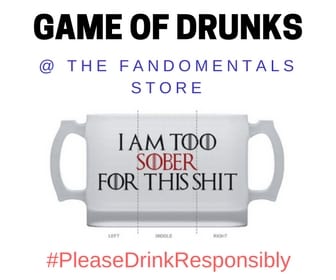Spoiler Alert: Game of Thrones through season 6, with some A Song of Ice and Fire details. Content warnings for discussions of domestic violence, abuse, and child death.
We continue our close analysis of the costumes on Game of Thrones (“GoT”) with a look at the evil queen herself, “Cersei” Lannister. I suggest perusing Kylie’s and Julia’s writings on the season five and six plotlines of King’s Landing to fully appreciate the shift from Cersei to Carol to Cheryl. To break it down for the purposes of this article you can think of them as the following:
- Cersei – a character on Game of Thrones that somewhat resembles her book counterpart. She appears in seasons 1-4, but is progressively replaced by…
- Carol – the doting super mom who fights for her kids and tries her hardest to protect them from legitimate danger, and is unfairly hated and criticized. She appears most prominently in seasons 5 and 6, but dies at the end of season 6 when, from her husk, emerges the evhul…
- Cheryl – the reborn super villain who broke forth from the Carol chrysalis, who stomps around Cheryl’s Landing wearing Gothic black leather, is an expert pyrotechnic, and does whatever she wants that Feels Good™. Cheryl is very Dramatically Satisfying™.
Note that these are three distinct characters based on their words and actions, along with a severe shift in fashion choice between Carol and Cheryl. Carol just couldn’t pull off leather like Cheryl.

Additionally, we continue this analysis looking through the Watsonian and Doylist lenses:
- Watsonian analysis: looking at the way a costume functions within the universe; how it is explained in the show, and
- Doylist analysis: looking at the reasons a costume came to be as a form of art created by real people; analyzing and critiquing real-world explanations
Finally, we consider whether a costume functions in its role. A costume may stand up to Watsonian or Doylist scrutiny if, at the end of it all, its purpose is fulfilled or is especially beautiful, creative, or unique in a good way.
Now we begin again another foray into A Song of Pins and Needles.
Embroidery Can’t Save Everything
We start by inspecting one of Cersei’s earliest looks, a powder-blue dress with beautiful bird embroidery.
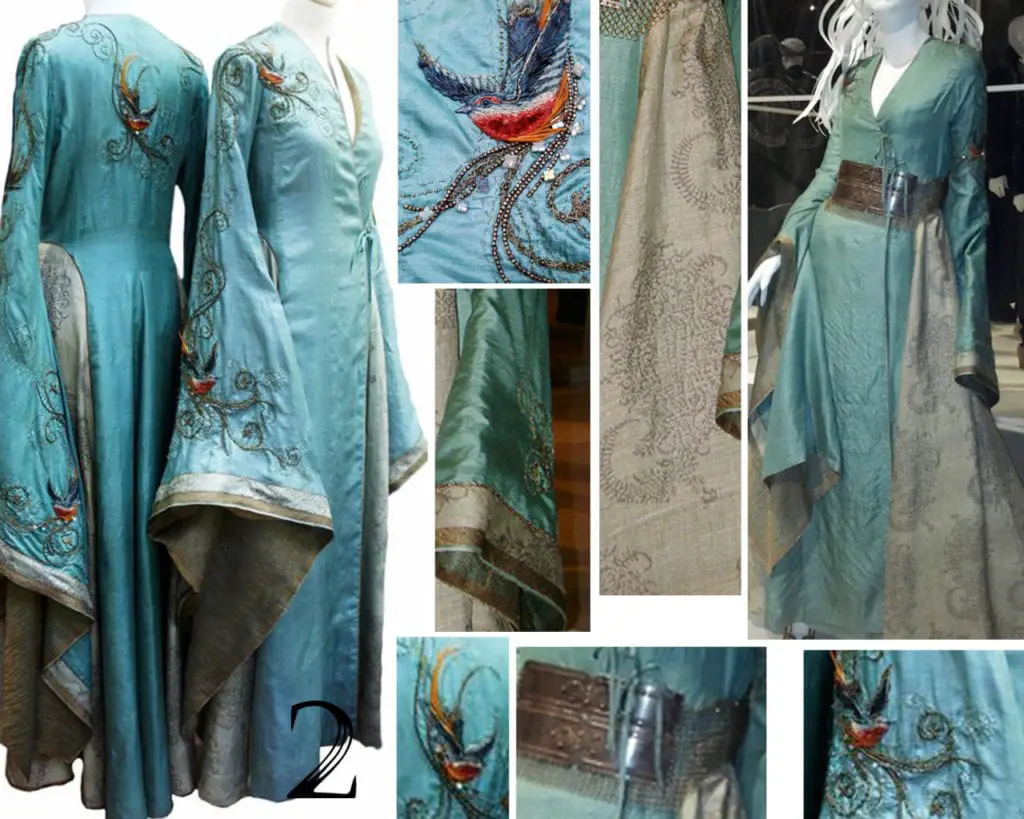
At first glance, this dress is fine. It’s a casual outfit for a queen. The fabric is nice, the embroidery is exquisite, the cut makes sense (more on this below), and a queen can’t wear crazy giant royal dresses every day of her life. It does function in its role as an acceptable royal garment for the intimate scenes in which it is warn (though I question its use when Cersei appears in public for Myrcella’s sending-off to Dorne, but YOLO). It’s also a pretty dress. I don’t hate it at all, actually. I just don’t understand the design.
Watsonian “In-verse” Analysis: Lannister Blue and the Birds of the Rock
As I have said many times before, this is a universe where color matters. Like, a lot. Each house has distinct colors and sigils, and wearing those colors and sigils shows your allegiance. Indeed, the costume designers are hyper-aware of this issue, as they make a point to put symbolic embroidery all over Sansa’s costumes. The designers also learned to color-code the characters for the audience’s convenience, as we see Cersei/Carol wearing almost exclusively red in later seasons. Let’s start by looking at the color issue here.
Color themes for wardrobes work in this society because the people have a motivation to pick specific colors. Cersei Lannister, the queen married into house Baratheon, certainly has reason to wear gold (shared color between her and her husband’s house), red (her house color) and black (her husband’s house color). Cersei’s lucky in that these three colors together would be badass as fuck, and the inclusion of gold makes it distinctly not Targaryen (wearing just black and red would definitely be a faux pas for the first queen after the fall of the Targs). But even if she wanted to shy away from red because of its association with Targaryens, Cersei still has gold and black to work with. Nowhere in this equation is there powder blue.
The problem with blue isn’t that it’s not one of Cersei’s house colors. Indeed, in the books, Cersei Lannister wears plenty of green to bring out the green in her eyes. It’s not that each house has a monopoly on certain colors. Rather, the problem is that blue is associated with a particularly powerful house, one whose lord attends the same court as Cersei: House Arryn, headed by Robert Arryn. Recall that Robert Arryn dies in the first episode under mysterious circumstances, and his death is what leads Ned Stark to start investigating the Lannisters.
And of course, we all know blue is a Dothraki color.
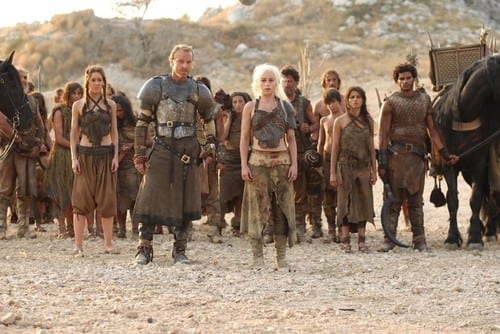
The color is odd, but alone is not enough to break the believability of the dress. Consider the blue color in conjunction with the embroidery. Cersei is sporting a blue dress with birds embroidered on it (shout-out to Michele Carragher for wonderful work, as always). Guess what house has a bird as its sigil? You got it – House Arryn.
Again, House Arryn doesn’t have a monopoly on birds. And yes, the birds of Cersei’s dress may not specifically be falcons, which is the Arryn sigil. But there is something to be said for a reigning queen wearing both the color and animal of another house, especially one that is present at court. It just doesn’t make the most sense. It could happen – maybe Cersei didn’t think it through so well, maybe her seamstress thought birds were pretty or something – but again, there are other designs that make more sense. Lions. Stags. Antlers. Even forest imagery, since stags live in forests. Birds are not connected to any of Cersei’s related house sigils, and they do relate to the Arryn house sigil. So at the end of the day, I don’t understand why Cersei would choose this dress, or why a seamstress would make this for the queen. Cersei wasn’t a huge fan of the Arryns, after all.
I stand bewildered with the Watsonian analysis here. Luckily, Michele Clapton is here to explain this dress to me.
Doylist “Real-Life” Analysis: Faulty Symbolism and Copyright Law
“When audiences first met Queen Cersei, she was arm candy for reigning King Robert Baratheon. So her kimono-style silk dresses were decked with flowers and birds, to show she was caught in a gilded cage.” —description from NY Daily News regarding interview with Michele Clapton
There is a running thread throughout the show, particularly with Cersei and Sansa, that birds symbolize fragility and captivity. This seems to be the driving motivation behind the design of birds on Cersei’s dress, which she only wears in seasons 1 and 2. Only after the death of the king does she start to wear her house colors and lion imagery.
This isn’t a horrible idea, and the contrasting images of a bird in a cage versus one free to fly can be a useful metaphor. Ignoring for the moment the issues with the Arryns, the problem I have with this symbolism is that we don’t actually see it played out. Embroidering flying birds on one of Cersei’s dresses doesn’t get this whole idea across.
Indeed, the idea fails because Cersei isn’t presented in seasons 1 and 2 as being constrained. She is the queen of the seven Kingdoms, and she always gets what she wants. She wants to sleep with her brother – check. She doesn’t want to have her husband’s children – check. She wants her husband dead – check. She wants to rule as reagent in place of her son – check. She wants Ned arrested – check. Season 1 Cersei is pretty good at getting shit done. The main constraint she has on her is needing to keep up appearances, which she is able to do while doing all the shit she wants to do.
There is also the issue of domestic abuse by Robert, of which we get little exposition or example. In fact, when Robert does strike Cersei on screen, she is defiant to him and lets him know he hasn’t really hurt her (“I shall wear this as a badge of honor”). It may have been possible to pull together a great metaphor using bird imagery with Cersei, especially in exploring domestic violence and how imprisoning that situation is, but it simply wasn’t put on our screens.
Finally, there seems to be some fandom belief (based on my Google-searching) that Cersei wears “kimono” dresses. I could not find any direct quotes from Michele Clapton confirming this, though Michele Carragher gives that description on her website. Just for clarity sake, Cersei wears wrap-dresses in a medieval style, not kimono dresses. A kimono is an important Japanese garment, which you can read more about here. There are certain rules regarding kimonos, none of which Cersei’s dresses follow. It doesn’t make any sense for Cersei to have a dress inspired by a kimono, since nothing in the universe remotely resembles a kimono. I even looked up modern “kimono dresses”, and they’re just wrap-dresses, as I expected. Wrap-dresses wrap around the body and tie somewhere at the waist. It’s just not accurate to consider Cersei’s dress a “kimono” dress, it certainly isn’t a kimono, and it doesn’t make any sense for her to be inspired by kimonos in this universe.
The problem is just that there are only so many ways to make clothes. In the end, your dress needs to have a torso and a skirt, and if you want sleeves there are a limited number of ways to design them. So a wrap-dress and a kimono may look similar at first glance simply because they are both dress-like garments. As a fun side-note, American copyright law does not allow the copyrighting of a lot of fashion design because clothing is primarily utilitarian and doesn’t have enough variety to be copyright-able.

In conclusion: blue is a Dothraki and Arryn and Lannister color, birds don’t innately have metaphorical meaning, and it’s not a kimono dress.
Remember When They Literally Put Armor on Cersei?
“Cersei is forced to wear ever more elaborately embroidered, armored dresses in an attempt to show her strength and her rightful place…” —Michele Clapton
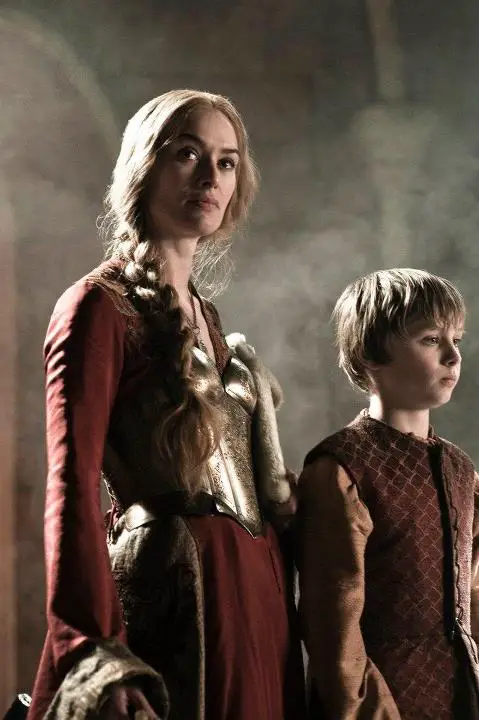
We can handle the Watsonian and Doylist issues of Cersei’s literal armor together, as they’re not that complex. First question: does this make any sense in King’s Landing of GoT or A Song of Ice and Fire? Answer: fuck no!
Nobody else has worn this style in the show (before or since). None of the little handmaidens adopt this style. Cersei has no in-world reference to pull this idea from. At best, the armor looks like a corset worn on the outside to be sexy; at worst, Cersei looks like she’s wearing an anachronistic costume among everyone else who is properly dressed. We have the same Metacademy of the Arts issues – who designed this? Who made it? Why? There are no other examples of armor shaped like actual breasts or anything like female anatomy up to this point.
Armor itself is associated with men because, in this feudal society, men wear armor as knights and soldiers. But in actual design armor is gender-neutral (except something like a codpiece!). A knight’s armor doesn’t have nipples, it doesn’t have abs carved into it, it doesn’t have anything that indicates a gender. There isn’t armor designed to look like any particular anatomy in Westeros – there is just armor worn by knights associated with manhood because of the gender requirements for knighthood. This corset-like armor (which fails to cover many vital organs, but drop in the bucket) comes out of nowhere and disappears back into that abyss soon thereafter, thank the gods.
Okay, watsonian done. Second question: why did the designers do this? Michele Clapton sheds some light on Cersei’s weird armor style that hangs around for season two and three. She says the armored dresses are an “attempt to show her strength and her rightful place”. Here we see masculine traits linked directly to strength and power. Men wear armor, so women who want to be Strong TM should, too. This seems to be an extreme version of Clapton’s explanation of Cersei’s jewelry:
“We use jewelry for Cersei a lot… When she’s feeling insecure, like with Margaery, for instance, she wears these big, clunky gold pieces to show that she’s a Lannister and important and has status.” —Michele Clapton
Cersei expresses her insecurity through wearing jewelry. This makes more sense, since status can be expressed by the riches you wear, and gems, gold, silver, and the like are signs of wealth. Her armor pieces are an extreme version of this jewelry-security-blanket thing, except that the breastplate doesn’t pass a Watsonian analysis. Additionally, the Blackwater breastplate just looks out-of-place. In and of itself it’s nice, but in conjunction with that dress something is off. It doesn’t function smoothly in its role.
Finally, there’s this gem:
“According to Clapton, Cersei wears lots of jewelry when she’s not feeling confident. In the finale, her look is simple and sleek—she’s feeling confident.” —from interview with Michele Clapton
Bring your receipts, please.
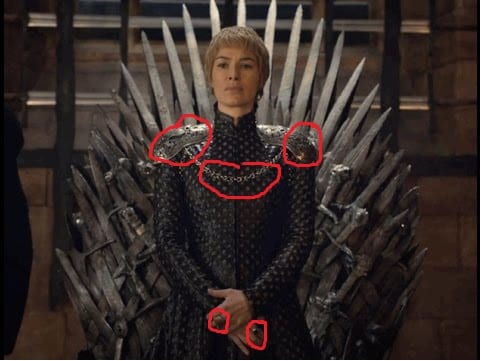
I should note that not all of her armor pieces are stupid. My favorite dress of hers has the nicest armor piece – it’s different but not ridiculous looking.
The Magical Multiplying Lion Necklaces
This has nothing to do with Watsonian or Doylist analysis, I just find the detail of the gold Lannister Lion necklaces entertaining. Part of the purpose of costuming is to create a consistent world for the characters – something the audience can rely on in understanding the story itself. The suspension of disbelief is broken whenever there are inconsistencies, and that applies to costumes as well. GoT in particular has a bad history with necklaces.
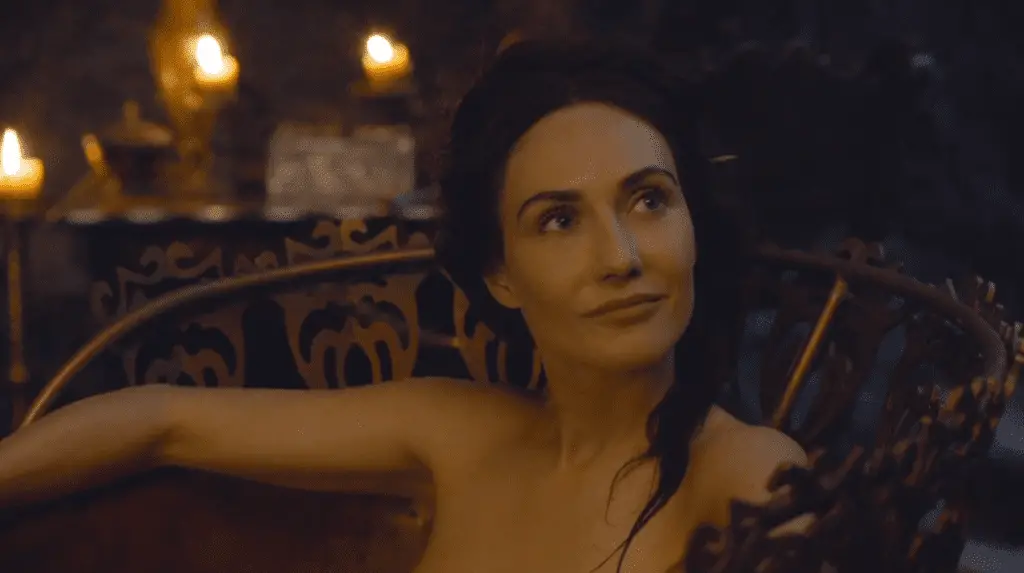
Take, for instance, the case of the mysterious multiplying lion necklace. From the get-go, Cersei Lannister wears a gold lion necklace. She has it in multiple scenes across multiple seasons. That’s neat! Some consistency! We also know Sansa has one because Joffrey gave it to her in season 1. Princess Myrcella has one as well, both before and after her magical growth from eleven to sixteen. Finally, Ros has one she got from Tyrion, though granted hers is a bit of a different style. Therefore, there are at least three identical necklaces in the universe, and four total lion necklaces. This shouldn’t be a difficult thing to keep track of for competent adults. Alas, this is GoT.
We are treated to possibly my favorite scene in the whole show, where Carol – formerly Cersei – receives a snek-in-a-box with one of these lion necklaces wrapped in its mouth. After opening the box and activating the pop-up snek, Carol is kind enough to put it back together so she can re-trigger it for Larry (formerly Jaime).
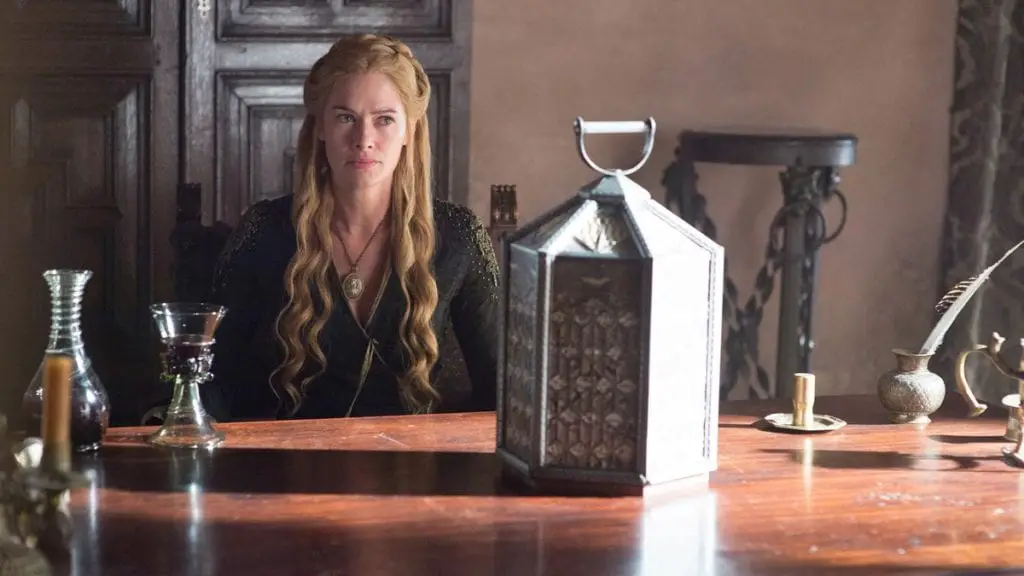
And then Carol tells Larry that it must be a message about Myrcella, because Myrcella had the same necklace and there is no other necklace like it in the world! Now, recall that Sansa received the same necklace from Joffrey and wore it non-stop from the time she received it until they were no longer betrothed, but then wore it again to her wedding to Tyrion Lannister. There is no excuse for Carol forgetting about Sansa’s necklace. There’s no excuse for the designers forgetting about it, either.
Indeed, it could have real ramifications if this is Sansa’s necklace, not Myrcella’s. It could mean the Dornish have Sansa, a very important political figure Carol has been searching for. It could be a declaration of war, then, if the Dornish are announcing their allegiance to Sansa Stark and the north, which recently rose against the crown. This could be returning Sansa’s necklace to her former captors, saying that she is no longer controlled by the Lannister yoke. This detail matters. There are other significant meanings to this necklace because Sansa had one, too.
Overlooking this detail breaks the suspension of disbelief. When I first saw this scene, I thought immediately of Sansa’s necklace, not Myrcella’s, and fairly so – we see a hell of a lot more of Sansa than Myrcella. There was a whole scene dedicated to Sansa’s necklace, not Myrcella’s. Why should the audience see this and think of the princess first? That is the problem with inconsistency: it interrupts the story and breaks the suspension of disbelief.
At least we aren’t at Talisa levels of breaking the story.
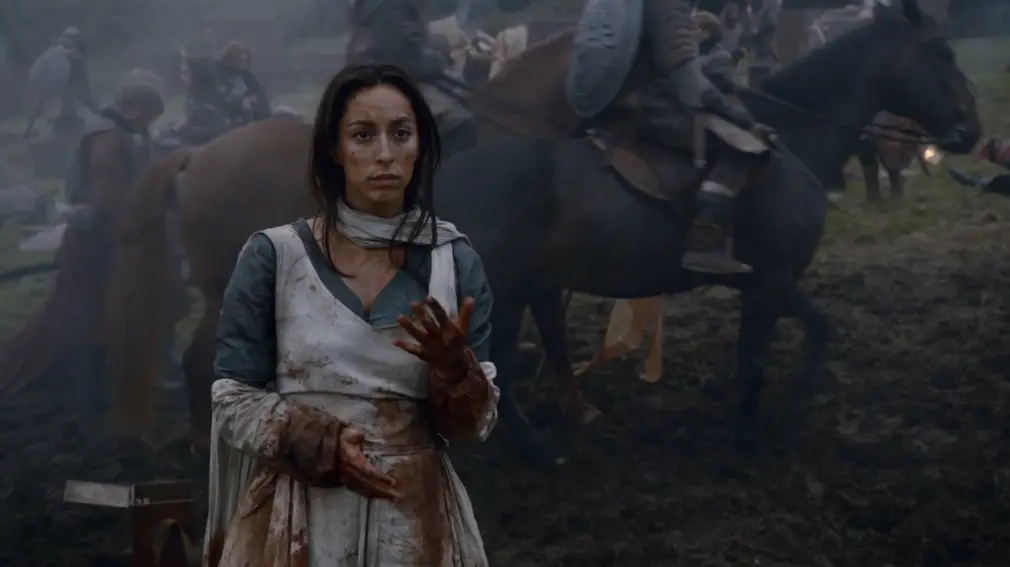
Seriously guys, make a spreadsheet or something to keep track of this jewelry. Organization is a good thing.
Cheryl Lannister’s Outfit of Supreme Evil
The Watsonian and Doylist greatly intertwine with Cheryl’s Outfit of Supreme Evil™, as we need the Doylist explanation from Clapton to analyze the Watsonian strength of such design. We will consider both together.
Watsonian and Doylist: How did Cheryl get here, and how did we?
“I knew it had to be leather and I knew it had to be linked to [Cersei’s father] Tywin… I wanted a distinct, strong silhouette, so I squared her shoulders. I also wanted the dress to skim her ankles, so that you could see her feet—again, strength.” —Michele Clapton
Every now and then I read something Michele Clapton said and I find myself agreeing with it – usually, at least, until the last sentence. The Doylist explanation of the design of Cheryl’s Outfit of Supreme Evil™ isn’t all that ridiculous at first. Squared shoulders do make a strong silhouette; there is a good argument that Cheryl would want to resemble her powerful father (Cersei of the books thinks of herself as Tywin “with teats”); and this dress does resemble the cut of Tywin’s clothing. Ignoring for now any anachronism issues, at this point the explanation holds enough water for me to refresh myself in easy, understandable logic. However, Clapton can always be relied on to confuse the shit out of me, as she does with the last line:
“I also wanted the dress to skim her ankles, so that you could see her feet—again, strength.”
This is a minor point in and of itself, but it plays into a larger pattern. First and foremost, this is a stupid sentence and a stupid thought. How in the world does seeing your feet make you powerful? Is it the shoes? Are her shoes the most Evhul™ part of the outfit??
Importantly, I think the answer to these questions lies in a more sinister place. One distinguishing feature between men’s and women’s clothes in the GoT universe is the visibility of feet, because women wear skirts and men wear pants. So there seems to be a connection between the masculine visibility of feet (not something I thought I’d ever write) and strength. But it doesn’t stop there.
Alone, this wouldn’t be an issue. It’s a small detail. But consider it in the pattern we’ve seen – specifically, consider Daenerys’s wardrobe. We know Michele Clapton thinks pants are powerful, and she makes Emilia Clarke wear pants under every single dress. Dany also always wears riding boots, even though they are markedly inappropriate for her Meereenese queenly attire and contradictory to the book material. Other female characters who sport pants and boots are “Brienne of Tarth” and “Arya Stark”, which later pieces will discuss in more detail. Just keep these bits of design in mind while we parse out what they mean. Recall:

Through costume design, Clapton is drawing a direct line between masculine qualities and strength. The pattern starts with Daenerys’s badass leather pants, continues with Brienne and Arya, and appears again with Cheryl’s Outfit of Supreme Evil™. We also saw it earlier with Carol’s armor corsets. This is part of the overarching pattern of sexism on the show. We repeatedly see feminine qualities degraded or diminished – see Sansa not sewing for an example – and masculine qualities heralded in a toxic way. These problems stem from the writing and permeate even the costume design of these characters. Most unfortunately, this permeation undermines the themes and purposes of the story lines in the source material, making the whole show a depressing thing to behold.
The lack of understanding of the source material continues with this costume, and introduces some more Doylist design questions. Clapton says of the metalwork on Cheryl’s costume:
“The silver shoulders are decorated in a similar manner to Jaime’s gold hand—the one person that she still has something with,” Clapton explained, noting that every detail of the dress represents something. “There is no ‘decoration’ to Cersei.” —Michele Clapton
The severe misunderstanding of Cersei’s and Jaime’s relationship is the topic of much discussion here at the Fandomentals, and rightly so. The creators turned an abusive, damaging, and complex relationship into your best OTP. I suppose it’s possible Cheryl got her bitchin’ shoulder pads commissioned by the same smith that made Jaime’s hand. I’m not even particularly opposed to that idea, since she commissioned both. It’s therefore possible for the two to have similar style, coming from the same artist. What matters more is the underlying premise – that Cersei and Jaime are so close, and that’s why they match! I mean, don’t you want your shoulder pads to match your boyfriend’s prosthetic hand?
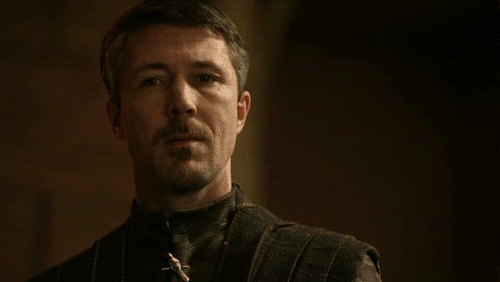
Finally, Clapton addresses the color choice. Black is the color of mourning in Westeros – Cersei wears black to Tywin’s funeral in A Feast For Crows, for instance – but whether book!Cersei would continue to wear black indefinitely is unlikely (she is annoyed at having to wear black again for her father’s funeral in Cersei II). However, dear Cheryl is quite far removed from Cersei Lannister, so expecting the two to be similar is like expecting this show to fix its woman problem: futile. Besides black being the color of mourning, it is also the color of the Night’s Watch, which has its own implications. It doesn’t make much sense for Cheryl to be in eternal mourning, especially if she is supposed to be “reborn” with her new power, but honestly the color is just a drop in the bucket at this point. The Doylist reason is that black looks badass and EVHUL, and I’m content with that.
Now, let’s all bask in the perfect logic that led to this outfit design:
“Black was the obvious choice… Yes, it is for mourning her children, her father . . . but it’s more than that. To me, it represents a deadness inside her—the overwhelming desire for power at any cost. The multi-layered effect created by mounting the leather onto silver brocade gives a more complex feeling, implying that nothing achieved is ever simple.” —Michele Clapton
Let’s look at the last line. Y’all know I’m a sucker for brocade – and using leather with patterned cut-outs is also my jam. My favorite outfit in the whole show uses this technique. It’s good enough to say “the multi-layered effect created by mounting the leather onto silver brocade” is AWESOME and looks SUPER COOL.
It really is acceptable to make a costume that looks nice and doesn’t have a deep meaning behind it, as long as it doesn’t break the suspension of disbelief. The idea to layer cut-out leather over brocade is neat. Adding unnecessary meaning makes the designer look a little stupid. Yes, maybe layering the fabrics gives it a “more complex feeling,” in that using two things is innately more complex than using one. But nothing about this outfit at all implies that “nothing achieved is ever simple.” What was achieved? The costumer made a dress with two fabrics? Is this supposed to be a great parallel to Cheryl’s accomplishments? Are her two things that she both blew up the sept and managed to sneak out Septa Spoonella?
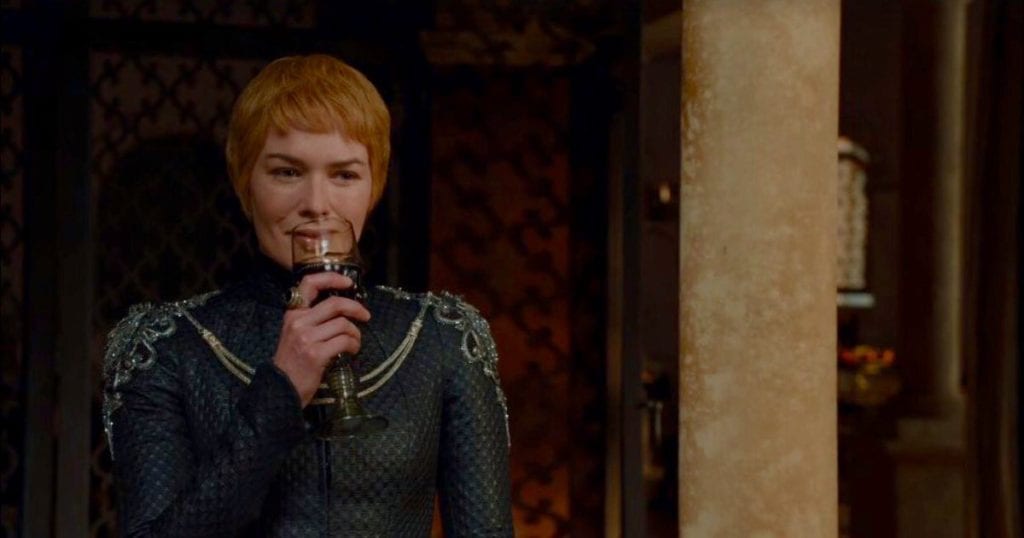
I have sympathy for Michele Clapton because she has to work with David Benioff and Dan Weiss (“D&D”). Being surrounded by that level of professional bullshittery and fart-sniffing would drive anyone mad, and I can see why she wants each of the costumes to have a deep meaning: the creative driving force of the show wants everything to have nuance, but simply doesn’t understand true nuance. It’s the same trickle-down effect we’ve seen all along. Everything comes back to the writing.
As far as any Watsonian analysis goes, this is one of those outfits that doesn’t really fall on either side of the fence. It looks anachronistic, since women in a medieval time period would never wear this; however, that is counterbalanced by the fantasy setting. Winter is coming, and leather is warm. Cheryl also wants to look like her father, who wore leather. So it’s really neither here-nor-there. The explanations for the design in-verse aren’t impossible. Note also that I *think* they made two almost identical dresses for two different scenes in the last episode. Honestly they look so similar it’s hard to tell if they’re different or if it’s just one dress plus shoulder pads. Regardless, the shoulder embroidery on the first version in bitchin’ as always.
More importantly, this dress is ugly AF. I mean, if someone told me black leather, silver brocade, and metalwork, I would be expecting a dress perfectly fit for my pessimistic little soul. Instead, we get a boring, ugly, football line-backer outfit that looks too prude even for a stage costume. Indeed, the covering of Cheryl – in a season already ripe with example of de-sexualization through covering – is certainly part of the sexist pattern we’ve identified throughout the show. Cheryl is so strong she can show her feet, hide her cleavage, and keep her hair short – basically, she is presenting as a man. This would be interesting commentary on sexism in a feudal society if this were any other show. But with its horrible history, and its clear misunderstanding of sexism, GoT only adds to the problem with this design.
Crown of Supreme Evil
“I chose to make it in silver with just wisps of gold to try to show her isolation, her mental disentangling from her family. There is no reference to [her late husband, Robert] Baratheon; there is no need anymore. She doesn’t have to try and prove a link. The center of the crown is the lion sigil abstracted — its mane represents the Iron Throne, her desire. She has made it her own — she is reborn.” —Michele Clapton
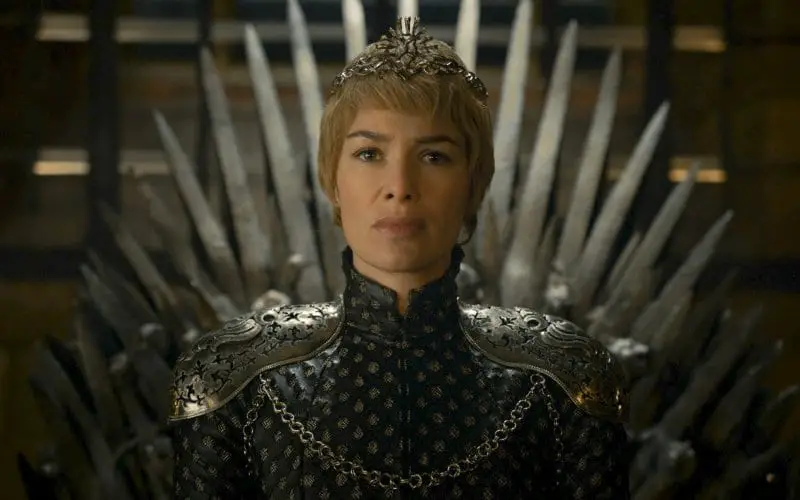
Cheryl’s crown presents a Watsonian dilemma, similar to what we’ve seen with Marg’s crown. The design is fine – it makes sense that it’s a lion and not a stag, unlike the crown that appeared for two seconds in season one – and it being abstracted is not unusual. Indeed, all the crowns we see have had some abstraction. Robert’s didn’t have a full stag; Joff’s, Tommen’s and Marg’s all share a combination of antlers and roses. The crowns draw inspiration from house sigils, but don’t just plant the house sigil in the middle and call it a day. Cheryl’s crown follows suit, using the lion of her house but making it fit into a crown.
Disregarding the fact that Cheryl Lannister shouldn’t have any power at all and that flaunting her Lannister-ness would only further negate her claim, the main problem that arises here is in the design. The silver with “wisps of gold” apparently shows Cheryl’s isolation and loneliness. First, how? What does the gold and silver represent here? Is she the gold wisp, alone in a sea of silver? Or is she the silver, with barely any gold left in her life? Is the gold wisp Jaime? Someone needs to give the whole GoT production team a lesson in metaphor and symbolism.

Second, did Cheryl employ someone from the Metacademy of the Arts too? There must be a section of the school in King’s Landing who commissioned this crown along with Marg’s outfits. Maybe they have a psychology department, where queens sit and confess their deepest feelings so the designers can make every little detail of their wardrobe have significant meaning. An in-universe designer would be absolutely batshit crazy to make a crown for the queen who just blew everyone up that shows how lonely and isolated she is! Like seriously, if Cheryl figured this out she would kill that designer. Cheryl doesn’t want to be seen as lonely as isolated. She wants to be feared! She would never commission such a design on her own. I like to imagine there is a single meta-designer just trolling the shit out of the royals. Maybe Cheryl will find them and kill them because it Feels Good™.
A Disappointing Pattern
As expected, we continue to get designs that fit the bad patterns (no pun intended) of sexism and toxic masculinity that permeate this show. Cersei/Carol/Cheryl Lannister is no exception to the rule, and rather reinforces the problem. Cersei Lannister of A Song of Ice and Fire is a fantastic study in internalized misogyny, which was just too nuanced for the creators to understand. We end up with an inconsistent character who is dressed in confusing ways.
Next on A Song of Pins and Needles, we will gaze back on when the show was mildly more cohesive to look at Only Cat.


